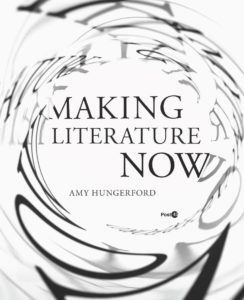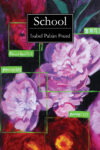Some weeks ago Amy Hungerford — a specialist in contemporary American fiction, a Professor of English, and Dean of Humanities at Yale — got the attention of literati inside and outside academia when she published an essay in the Chronicle of Higher Education that explained why she refused to read David Foster Wallace’s Infinite Jest. To someone who has read it and used to, like Hungerford, teach university courses in contemporary American fiction, her argument seemed strange and maybe professionally irresponsible since, in my experience, Infinite Jest is the American novel most read by literature students outside the classroom. Millions of people rightfully choose not to read Infinite Jest every day, but how would Hungerford explain to her students her adamant resistance to this cult, possibly iconic, and perhaps truly important book without reading it? The Chronicle essay appeared to be a provocative trailer for Hungerford’s recently published book, Making Literature Now. Although I’m no longer a professor, I’m still interested in how literature and reputations (a subtext of Hungerford’s piece) are made, so I volunteered to review the book. You Are Here.
Hungerford’s Chronicle essay is a condensed and defanged version of the last chapter in Making Literature Now, which, like a novel with an unreliable narrator, has its undercutting self-revelation at the end. The narrative begins as a road story. Not content with reading books, reviewing them in the Yale Review, writing about them in scholarly essays, and lecturing about them in New Haven, Hungerford wanted to get out in the world and investigate the process of book-making. In her first two chapters, she reports how she went to San Francisco and was charmed by Dave Eggers and his happy folk at McSweeney’s. They were a sociable group putting out magazines and books for another sociable group, those who liked the producing group’s studied amateurism and fuzzy good will to all. It distresses Hungerford to report that being published by McSweeney’s led to success for very few writers, and one of those successes — Deb Olin Unferth — may have betrayed the McSweeney’s/Believer vibe by changing the protagonist of her novel Vacation from female to male in order to publish with a more commercial press.
Searching for literary success she can believe in — success that occurs without commercial publication and its attendant promotional machinery that she will later claim created the phenomenon of Infinite Jest — Hungerford uses her next two chapters to discuss a novel app and a collaborative project (in which readers contributed to online) designed by people influenced by or associated with the Eggers atelier. These are interesting experiments that Hungerford ruefully admits in her epilogue were failures and no longer in existence. She mentions no other digital experiments in narrative, though the Electronic Literature Association has a website that could have directed her to plenty of writing outside the empire of commercial publication.
By following only the Eggers trail, our investigator also ignores the many non-profit or barely-for-profit print presses that are responsible for publishing numerous volumes of literary fiction of the kind reviewed in this magazine and in many other non-profit periodicals and literary websites. Hungerford wants to be a sociologist of literary “making” but fails to do the kind of research (she wouldn’t even have needed to travel, as she did to San Francisco) that could substantiate her grandiose title. She could have read the back-page interviews with small press publishers in American Book Review. She could have talked to people at little Lookout Press that received a National Book Critics Circle award for Edith Pearlman’s Binocular Vision or the one-man house of McPherson that released the National Book Award winning Lord of Misrule by Jaimy Gordon. What about Coffee House, Melville House, Counterpoint, Dalkey and Dzanc? How do they survive? Hungerford doesn’t inquire.
Discouraged by her findings initiated at McSweeney’s, Hungerford gives up on sociological research and does what professors do best: close analysis of a single novel within various critical contexts. Hungerford allows her students to choose the final book in her contemporary fiction courses, one of which is online as part of the Open Yale Course project. The year the course was filmed the students chose Jonathan Safran Foer’s Everything Is Illuminated. (I wonder what she would have done if they had selected Infinite Jest.) By referring to interviews Foer gave about this Holocaust novel, Hungerford manages to question his commitment to history and suggest that his postmodern approach to a “Big Subject” was adopted to gain attention and sell books. These could well be true, though her accusations might have been more persuasive if directed at Foer’s 9/11 novel Extremely Loud and Incredibly Close. But this chapter does, at least, show that she read Foer’s novel.
Now, Hungerford on Wallace. Her Chronicle essay was being forwarded and linked among academics because it led to general issues of what can be responsibly not read by literary professionals who do not want to be dependent on books recommended by the literary press. But Hungerford’s book chapter varies considerably from the essay. In Making Literature Now, she describes motives that were scrubbed from the Chronicle essay. In the book, she says she had read a few of Wallace’s short fictions and found them or their narrators misogynistic. She discovered in D.T. Max’s biography of Wallace that he used women (“audience pussy”) and slept with his students. She then decided that Infinite Jest had nothing to say “about women, or gender, or sex, or misogyny that’s worth attending to,” so she refused to read the novel. She recommended not talking about it and not writing about it to resist the promotional campaign, she says, that made the novel and Wallace famous. Except, of course, she was writing about the novel in the Chronicle and trumpeting her ethical purity while drumming up attention for her book.
The crucial error that the willfully ignorant Hungerford made was assuming that Infinite Jest is about misogyny and is misogynistic in its relation of author to reader. The novel is about a lot of things—conditioning, addiction, entertainment, monstrosity in all its forms from the physiological to the political—but not misogyny in any fundamental way. Quoting one of Wallace’s narrators in an earlier story, Hungerford believes Wallace wants to “fuck” the reader when, in fact, his form and style seek to “fuck up” or create cognitive dissonance in readers. Hungerford’s refusal would raise an interesting question if the work considered great by a number of critics was reprehensible, but she does not succeed at making this case with Infinite Jest.
For the obtuse, novelists sometimes plant a killer clue near the end of an unreliable narration. Hungerford undermines herself and her gesture of refusal in this final chapter by describing a discussion with and including correspondence with an editor at the Los Angeles Review of Books about a version of this chapter on Wallace. The editor tells her “for the essay to work as a convincing critique of Wallace and not just evidence of personal antipathy, it needs to have more of a grounding in Wallace’s writing.” Hungerford refuses the editor, she says, because “the scholar [she] in this case had tenure, and because she did not in a professional sense need to publish the essay.” Amy Hungerford, tenured Professor of English at Yale, does not need, as less fortunate literary scrabblers might, to accept an editor’s reasonable request for textual evidence of the kind that Professor Hungerford would probably and responsibly ask a student to produce. And it turns out she really didn’t need to offer evidence because the Wallace material and the book it ends were published by Stanford University Press under the “Post 45” imprint.
Hungerford makes Infinite Jest represent how commercial publishers and their enablers in the mainstream media engineer a novel into a canonizable success. The market is corrupt, she says. But is it any more corrupt or distasteful than the publication and marketing of her university press book? “Post 45” is a scholarly association; Hungerford is one of nine Board members. Two other Board members are the series editors for the “Post 45” imprint. The “Advance Praise” for Making Literature Now includes effusive comments by two people whom Hungerford praises in the book, a blurb by a former colleague at Yale, and other comments so hyperbolic that they appear to have been written under the influence of laughing gas. Hungerford put out a misleading trailer for the book in the Chronicle, excising the misogyny charge that’s essential in her closing chapter, perhaps because she feared anyone who had read Infinite Jest would see through that charge and not order Making Literature Now. Her title is grandiose because her data is extremely limited. Rather than the survey that the title implies, Making Literature Now is literary tourism combined with two takedowns.
Does the reader sense some antipathy from the reviewer? I reviewed Infinite Jest and later wrote about it in connection with other prodigious novels by William Vollmann and Richard Powers, but I have no investment in the Wallace industry and no desire to defend the person revealed in Max’s biography. My irritation (antipathy is too strong) with Making Literature Now arises from the author’s sense of entitlement, an authority she does not earn. She complains about all the constraints on her reading time, which disallow, she says, a month of reading for Wallace. In the Chronicle essay, she approvingly refers to the critic Gabriel Zaid who “argues that excessively long books are a form of undemocratic dominance that impoverishes the public discourse by reducing the airtime shared among others.” Unfortunately, Roberto Bolaño is dead and unable to profit from this ridiculous comment. Continually reminding readers of how busy a person she is, Hungerford speaks of her need for pragmatic “resource allocation.” This is the language of an administrator, not a literature lover. Maybe Dean Hungerford should resign from her administrative duties and clear some time to read works she talks about and find out about the presses she doesn’t talk about. Also irritating is the discrepancy between her supposed support of alternative publishing and the books she asks students to read. If you look at the syllabus for her lectures available on YouTube, you won’t find a single work from an alternative press, few recent books, and not a single encyclopedic novel such as Infinite Jest.
You may be wondering: why 2300 words about a book that will probably be read by 23 or perhaps 230 academics? Hungerford complains about the power of the commercial market to make reputations, but doesn’t “interrogate,” as professors say, her own institutional power — her role in Post 45, her influence over the hundreds of students who take her courses, her leadership of a Humanities division. She admits she has a graduate student whose dissertation includes Infinite Jest, but that fact does not move the professor to serve the student. Hungerford thinks of herself as a rebel, a Bartlebyian refusenik. But unlike Bartleby, Hungerford has the security of her tenured position. She prefers not to read Infinite Jest and asks, “What if we start suggesting something else to read, instead?” But Hungerford doesn’t name, in this chapter or in the Chronicle essay, a single book that she did read or could have read in that month of time when she freed herself from Wallace’s novel. Rather than a true and active proponent of the alternative literature that she says she values, Hungerford is a theorist of exclusion and a careerist maximizing her “resources.” As such, she represents — again, in my experience — the bureaucrats of literary studies I knew who refused to engage with and teach troublesome or difficult or lengthy works such as Infinite Jest.
If Hungerford had been writing in 1924, say, before Ulysses was canonized, she might well have said it was too much trouble to read, and she probably would not have read the sexist Tropic of Cancer when it was published, and certainly not Naked Lunch — and would therefore know nothing of works that have given permission to later writers to pursue their experiments in making literature now. I believe that tenured literature professors should be even more intellectually fearless than our novelists who, Hungerford rightly observes, are at the mercy of the market. She accuses Foer and Wallace of employing postmodern methods to gain popularity in that market, but she ignores the difference between their two novels. Foer’s can be easily consumed, Wallace’s not. The impediments and complications of Infinite Jest make readers work. But in the future, when the consumer-friendly products of McSweeney’s and when Hungerford’s moralistic and uninformed dismissal are long forgotten, Infinite Jest will, I believe, still be read and argued about. Join the fray, Professor Hungerford. Maybe you can write an analysis of Wallace’s novel that will forever quiet his fans and followers.
That’s the future, but You Are Here in the present. I can’t very well ask you to refuse Hungerford without reading her, but she has unwittingly freed you from the market. You don’t have to buy Making Literature Now. The free Chronicle essay should be enough to demonstrate her limitations as a contemporary critic and the limitations her kind of self-censorship would place on imaginative fiction.
Tom LeClair is the author of three critical books, six novels, and hundreds of reviews and essays in national periodicals.
This post may contain affiliate links.








